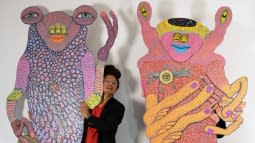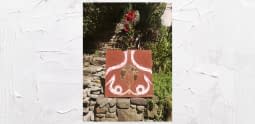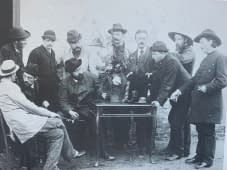Magic, Myth, Fantasy - Surrealism in Art and its Impact to this Day
Winged beings, mystical creatures, apocalyptic, mysterious-magical landscapes, grotesque, threatening, paradoxical situations, indefinable symbols, signs with an erotic undertone: Surrealist images are as diverse as their creators and their personal experiences and preferences. Even if the rejection of all reason and explanation, the detachment from traditional art movements, the protest against bourgeois boredom or the expansion of the consciousness through intoxicants and hypnosis are helpful for a definition of surrealism, as the «supra-real» world of images knows countless gradations, characteristics and nuances.
What is hidden behind the visible world that can only be grasped mentally? What is hidden beneath the surface of things that surround us? Is the world really as we perceive it? Such and similar fundamental questions, which for centuries challenged philosophers such as Anaxagoras' thought that «visible things form the basis of knowledge of the invisible», Plato's «Theory of Soul» (ca. 335-322 BC) or Immanuel Kant's «Critique of Pure Reason» from 1787, challenged exciting insights and explanations, which towards the end of the 19th century increasingly also interested artists. The time was ripe for trends such as Symbolism, which emerged around 1880 and, in its radical rejection of realism and naturalism, embraced new kinds of subjects in which feelings, dreams, fears, but also the unconscious and the imaginary were allowed to play an important role. And the time was just as ripe for occultism and spiritualism (cf. works by Hilma af Klint, Swedish pioneer of abstract painting) as for Sigmund Freud's book «The Interpretation of Dreams», published in 1899, and for artists around and after 1910 who were on the trail of the «spiritual dimension» of art. Among them, for example, Wassily Kandinsky (On the Spiritual in Art, 1911), the founders of metaphysical painting in 1917 (Pittura metafisica), Giorgio de Chirico and Carlo Carra with their endeavour to show reality beyond things, or Paul Klee, who stated many years before the official foundation of Surrealism: «Art does not reproduce the visible, but makes visible» (Schöpferische Konfession, 1918).
Surrealism, developed in Paris around 1920 and theoretically anchored four years later by André Breton in the first manifesto, was able to flourish in this diverse, fertile breeding ground. Fantasies, visions, nightmares, dreams, secrets, abysses of the human soul, desires and suffering became countless sources of inspiration for artists in the surrealist environment, which they visualised in disturbing, absurdly insane, mysteriously «surreal» works, sometimes with autobiographical allusions. While names such as Salvador Dali, René Magritte, Max Ernst or Yves Tanguy may be familiar today as representatives of Surrealism, the once successful artists associated with the Surrealist scene such as Leonora Carrington, Leonor Fini, Dorothea Tanning, Remedios Varo or Victor Brauner are unjustly overlooked. Fortunately, the wide-ranging exhibition «Surrealism and Magic: Enchanted Modernity» at the Museum Barberini in Berlin (until 29.1.23) and highlights the multifaceted diversity of this fascinating art movement.
The fact that the enormous radiance of surrealism has been effective far beyond France from the 1920s to the present day may be illustrated through a few exemplarily selected international artists and their works, each of which follows the individual life of the soul:
Early on, the French artist Félix Labisse (1905-1982) was classified as a surrealist because of his imaginative, sometimes erotic pictures with fluid boundaries between reality and appearance, between reality and the fantastic, supra-real sphere. Labisse, who also worked for film, theatre, design and dance and was a friend of René Magritte and Max Ernst, among others, was a colourful personality. His life was filmed by the film director Alain Resnais in 1947.
Alberto Depietri (*1928) creates pictures full of longing and melancholy, reminiscent of the metaphysical paintings of Giorgio de Chirico. The Italian artist mixes the past, the present and the world of dreams and shows how important the perfect use of painterly techniques is to him with motifs that are reproduced precisely and in great detail.
The Swiss painter Paul Raclé (1932-2019), who copied works by the surrealist Salvador Dali as a teenager, celebrated his first successful exhibition in Zurich in 1958. From that time onwards, Raclé became increasingly interested in surrealist role models again, which he mixed with references to fantastic realism, until he painted works with dreamlike-visionary contents that are reminiscent of the Grisons artist, set and costume designer for «Alien», H. A. Giger, among others.
With the Swiss artist Maximilian Hilpert, we enter another very individual, unique surrealist world full of magical, mystical and absurd nuances. At the same time, he always remains committed to figurative painting, which in its richness of detail challenges us to create diverse stories and associations. As Hilpert once said himself, he was «far too little known in Switzerland due to his constant residence abroad». A pity, because the magic of his work is still as powerful as ever.
For the contemporary, philosophically inspired artist Minò, who lives in central Switzerland, intuitive painting that «flows out of itself» is important («I am a pure emotional painter to whom colours are existential»). In this way, he creates expressive landscapes of the soul, sensitive poetic dream worlds and webs, which in their timeless way inspire the viewer to develop individual thoughts and interpretations, let them take off or dive down - depending on one' s own imagination.
The main thing is to be far away from all reason.








